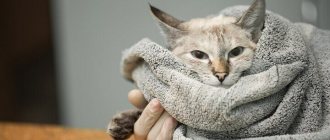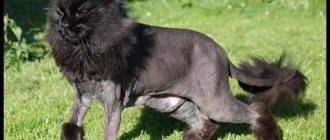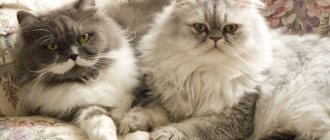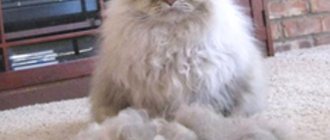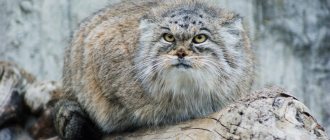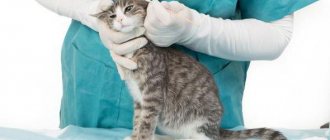Cat fur serves as an insulating layer between the skin and the external environment. The coat protects from cold and heat. Its type is classified depending on the thickness, length, and structure of the hair.
The type of cat's coat is an individual feature of each breed, regardless of color, and is determined by a specific combination of guard hairs, guard hairs and undercoat.
Undercoat
The undercoat consists of soft and fluffy hairs of equal diameter along the entire length, providing thermal insulation. It is the undercoat that helps animals keep warm during cold periods and protects them from overheating in hot weather. Without proper care, the undercoat becomes compacted, tangled, and tangles form. They are much larger in number, in contrast to the protective and guard layers, and they are the shortest, lying close to the body. When examining the undercoat under a microscope, it will appear corrugated (wavy), although at ordinary glance it appears straight.
Guard hair
The guard hair, or outer hair, forms the main middle layer of the coat. They are thinner than protective hair, stiff, with a thickening at the tip. The structure and length may vary depending on the breed. Some breeds have a awn that is the same length as the guard hair, while others have a shorter awn.
Protective hair
The guard hair usually determines the cat's base color. The protective top layer prevents the wool from getting wet quickly. Typically, guard hairs are longer than guard hairs, and are stiffer and coarser. They taper evenly to the tip along the entire length.
Pooh
Sparse, very fine hairs, characteristic of kittens. By the way, sphinxes’ hair is also called fluff. In adults, the down is difficult to distinguish.
Mustache
Vibrissae are long, thickened tactile hairs growing on both sides of the muzzle on the cheeks and above the eyes, as well as on the outer side of the lower leg. Vibrissae are very sensitive and important in a cat’s life. They cannot be cut, because with the help of whiskers the cat orients itself in space: it measures the distance to an object, finds its way in the dark, determines the direction of the wind, and recognizes odors. Whiskers are one of the ways cats communicate.
There are breeds with double or triple coats. Many people believe that some breeds do not have an undercoat, for example, the Turkish Angora, but in fact they do, it’s just weakly expressed, it is less abundant, unlike other breeds. Representatives of the Cornish Rex breed lack a awn, and wirehair cats have all three types of hair, they are all short and curly.
By the way, hair structure is determined genetically. Straight and curly hair in cats differ only in the shape of the shaft. Curly hair has a flat shaft, while straight hair has a round shaft.
Cat fur length
Hairless rocks
Despite the name “hairless,” there are no naturally hairless cats. Even hairless breeds have very short, fine hairs on their bodies, most noticeable on their limbs. But they are not enough to protect the skin from exposure to low and high temperatures and sunburn. Hairless breeds have whiskers and eyebrows, but they are shorter than other coated breeds.
A recessive gene is responsible for the lack of hair, which must be present in both parents in order for hairless kittens to be born. Hairless breeds include the Sphynx, Peterbald, and Bambino. The lack of full fur makes it easier to care for animals, but they tolerate cold less well.
Shorthair
Most cat breeds have short hair, less than 5 cm long. These include the British Shorthair, Bombay, Burmese, and Bengal breeds. But there is significant variation in texture among different breeds. For example, Siamese and Oriental cats have short, but smooth, very soft, close-to-the-body fur, while the Russian Blue has a thick double coat, soft and silky in texture.
The coat of shorthaired breeds requires minimal grooming. Brushing 1-2 times a week will help maintain a healthy and beautiful appearance of the animal, get rid of dead hair, and prevent the formation of tangles.
Semi-longhair
This concept applies to breeds with long hair, but not such a thick and fluffy undercoat compared, for example, with Persian and Himalayan cats. As a rule, in semi-long-haired breeds there is a noticeable difference in the length of the coat in summer and winter. These breeds include the Maine Coon and Burmese cat.
Longhair
Representatives of some breeds are characterized by wool reaching a length of up to 12 cm. But the length depends on the breed and the season of the year. In winter, the coat is typically longer and thicker, providing insulation from the cold. Long-haired breeds require careful care, because the wool is prone to tangling, and debris in the form of seeds and twigs gets stuck in it. Animals shed profusely. Therefore, you need to care for long-haired animals every day.
Long-haired breeds include Persian, Neva Masquerade, Himalayan, and Scottish longhair cats. A recessive gene is responsible for long hair, so to produce long-haired kittens, parents who are carriers of this gene are needed.
Hair loss is a serious symptom
Seasonal shedding in cats lasts from two to three weeks to one and a half months; the age-related change of coat in kittens can last for six months. In theory, anything outside these parameters should be considered an abnormality. But there is a nuance: as we said, after moving into houses, our smaller brothers can shed all year round, while remaining completely healthy.
Domestic cats can shed all year round
Yet hair loss in animals is often a symptom of a disease or other health disorder, and domestic cats are no exception. Thus, a paradoxical situation arises: the same external manifestations can be either a kind of “payment for shelter” or an alarm bell. In one case, nothing needs to be done, moreover, an attempt to treat the animal can cause harm to it, and in the other, the pet, on the contrary, needs qualified help. The problem is so difficult that even an experienced veterinarian is not always able to solve it. But a responsible animal owner simply must do this. So the cat is shedding. Most likely, everything is fine with her if:
- the skin visible between the hairs retains a natural and uniform color;
- the fur does not fall out in clumps, leaving bare areas of skin (bald spots can appear behind the ears, above the eyes, on the stomach, thighs, and the inner surface of the paws);
- the pet’s behavior has not changed, the cat looks healthy, eats well, digestion is not upset;
- urine and feces have normal color and odor;
- the animal's nose is moist, its eyes are shiny;
- there is no frankly unpleasant odor from the mouth;
- Body temperature, if you can measure it, is normal (in cats it is between 38.0 and 39.0).
In a word, you need to understand a simple thing. Hair loss is almost never the only symptom of a particular disease: as a rule, there are other signs. Finding them or making sure that they are absent is the main task of the owner. Let's look at some of the most common causes of pathological hair loss in cats.
Hormonal disbalance
When experts strongly recommend sterilizing domestic animals of both sexes (with the exception of those specifically used for breeding), they know what they are talking about.
It has been observed that sterilized cats live an average of 15–20 years. For comparison, the average lifespan of a domestic cat is 10–12 years; outdoor cats rarely live past 5 years of age. And if the difference between a pet and an animal forced to fight for survival can be explained by the quality of life (in civilized countries people also live longer than in backward ones), then the obvious advantage of sterilized animals over their no less “caressed” brothers is explained by only one thing - the absence hormonal shocks.
In favor of sterilization, it should also be said that cats, like the vast majority of animals, do not have such a thing as orgasm. Mating and childbearing, contrary to the opinion of some “humanists,” are not beneficial to the cat’s health; this is just a natural need to preserve the species, which in the case of pets is perfectly solved through targeted breeding.
If you do not agree with the position accepted as the basis throughout the civilized world, at least take the trouble to ensure your animal’s full realization of sexual instincts, but under no circumstances do you stuff it with hormonal drugs that suppress sexual desire, and do not endure heart-rending screams while clenching your teeth unfortunate beast.
This is inhumane and very dangerous for the cat’s health.
Estrus causes a lot of inconvenience for a cat and its owner.
Severe hair loss is often caused by hormonal imbalance, and the latter, in turn, is inevitable when taking various “anti-sex medications.” The same reason, by the way, explains the increased shedding in cats after estrus, during pregnancy and after childbirth: hormones go crazy - just like in humans.
Stress
We come to another problem that can cause hair loss. This is an emotional shock.
Usually a cat knows how to stand up for itself
But there are factors to which even these proud and independent creatures react very painfully. These include, in particular:
- moving (the well-known formula that a dog is attached to its owner, and a cat is attached to the house, is only partly true, but there is certainly some truth in it);
- transportation, especially in tight carrying;
- painful medical procedures associated with anesthesia, fixation (tying up) and other violations of “personal integrity”;
- the appearance of another animal in the house, especially if it is perceived as a source of danger or a “competitor”;
- loneliness, especially if for the first time the animal is left alone in an empty room for a long period of time;
- a sharp change in attitude towards oneself on the part of the owner;
- the introduction of new rules and restrictions that did not exist before (for example, a cat got used to sleeping with its owner, and at some point they stopped allowing it to do so).
The cause of hair loss may be longing for its owner.
In a word, if a cat begins to lose a large amount of hair, think about whether something happened that provoked strong feelings in the animal.
Allergy
Allergies in cats are usually accompanied not just by hair loss, but by the formation of bald patches (so-called alopecia).
But the opposite rule does not work: allergies are not the most likely cause of baldness in individual areas of the skin, and their localization in this case will not clarify anything.
One of the causes of receding hairline is allergies.
The only correct course of action is to analyze whether there have been any changes in the diet, and if there have been, exclude the probable allergen, and then continue observation.
Poor nutrition and dysbiosis
A cat's diet must be balanced; food from our table cannot replace it.
High-quality cat food contains everything necessary for the health of the animal. Adherents of natural food need to put in a lot more effort to make their pet's coat shiny and glossy.
Sometimes the cause of hair loss is dysbiosis, which is not caused by nutritional problems, but, for example, by recent antibiotic treatment. In this case, shedding is usually accompanied by other characteristic symptoms, primarily intestinal dysfunction.
Old age
As we age, various diseases appear and worsen, and the body begins to work like a poorly regulated machine. The same thing happens with cats.
In an older animal, the fur coat loses its thickness and silkiness, becomes tangled and falls out, sometimes forming quite distinct bald spots.
This is a natural and, unfortunately, irreversible process.
In old age, the animal’s fur no longer looks thick and silky.
Diseases in cats
Increased hair loss can be a sign of a disease, either skin, caused by parasites or fungal infections, or internal. The first category of diseases includes:
- ringworm (fungal infection, pathogens - dermatophytes);
- demodicosis (caused by subcutaneous mites);
- dermatitis (can be caused by bacteria, fungi and even flea bites);
- scabies (caused by the Notoedris cati mite);
- eczema (can be caused by various reasons).
All these diseases have a very clear clinical picture, the lesions are clearly visible, and if you consult a specialist in a timely manner, diagnosis and treatment do not cause problems.
Ringworm is an infectious skin disease of a fungal nature.
The situation is more complicated with systemic internal diseases, which at a certain stage begin to acquire external manifestations, affecting, in particular, the quality of wool. In fact, this symptom can be caused by literally anything: from endocrine system disorders, including diabetes, to neoplasms.
In such cases, hair loss is a secondary symptom; therefore, there is no point in fighting it: you need to look for the cause of the disease and treat it.
What is the difference between wool and hair?
All mammals have hair, be it human, pig, elephant, whale, cat or dog. But they have different appearances, depending on their functional purpose. Technically speaking, the term "fur" applies to mammals with very thick hair. The term "coat" is used for cats, except for hairless breeds, which have a minimal amount of fur, so the term "hair" is applied to them.
But like everything else, cat hair grows from follicles under the epidermis, although they come in different types and structures. By the way, a mustache is also considered hair. Cats have different types of hair growing from the same follicle. Each awn is surrounded by 6-12 fluffy hairs.
Hair has different textures and lengths on different parts of the body. Their density varies from breed to breed, the number of hair follicles in certain areas of the body. But on average, the density of the coat is about 200 hairs per square millimeter.
Directly under the skin are hair muscles that are sensitive to changes in ambient temperature. When a cat is scared, anxious or cold, the muscles tense, raising the hair. Protruding and fluffy, they give the animal a “frightening” appearance.
Types of hair in cats and description
Coat types, which are an individual feature of the breed, are classified based on the length, thickness and structure of the hairs.
In addition, the specific combination of guard hair, guard hair, and undercoat is determined. Based on this criterion, the following types of cat hair are distinguished:
- Undercoat. This is soft, fluffy fur, the main function of which is thermal insulation. It is the presence of undercoat on the body that provides the animal with reliable protection from the cold in winter and from the heat in summer. If you do not take care of the coat and comb it in a timely manner, this layer becomes tangled. The animal looks unkempt and sheds heavily. However, some breeds, such as Orientals, have no downy hair at all.
- Guard hair. Forms a middle covering layer. At the base the hair is thinner, and at the tip it thickens. The structure and size vary depending on the individual characteristics of the variety. One species has guard and guard hairs of the same length; in others, the guard may be shorter.
- Protective. It differs from other types in that it has a rigid structure that protects the animal’s body from getting wet. The hairs are wider from the base, but gradually narrow towards the tip. It is this type of cat fur that determines the main color.
- Pooh. Grows in kittens and sphinxes. The hairs are very thin, sparse, and difficult to distinguish in adult representatives.
- Vibrissae. They are long whisker hairs that take an important part in the life of the animal. Whiskers are located on both sides of the muzzle, above the eyes and on the outside of the lower leg. It is forbidden to cut off tactile hair, because without it the animal will not be able to fully receive signals from the outside world and fully communicate with its relatives.
Are there allergies to wool?
Cat saliva contains particles of the Feld1 protein, which gets onto the fur when the cat licks its fur. The particles dry out, turning into microscopic flakes, and they are the allergen. Some people, misled, look for animals without fur, believing that there are no allergies to them. In fact, there are no breeds that do not cause allergies, but some cat breeds are hypoallergenic, meaning they are less likely to cause allergies.
Similar articles:
- Declawing cats
- Cats with the character of a dog
- Cat Day
- Cats from advertising
- Cat foster care
- Fertility of cats
How to deal with shedding
Almost all cat owners ask this question. Some are sincerely concerned about the health of their ward, others are more concerned about the condition of the furniture and carpets.
Let's reveal a terrible secret: hair loss in cats cannot be cured.
Inaction is the best course of action
Above we have listed the six most likely causes of excessive shedding. Of these, only the last requires intervention, and only because hair loss in this case is an indicator of the presence of a disease that needs treatment. Moreover, there is no need to “help” a cat with seasonal or age-related (children’s) shedding; this process, even if it lasts for a whole year, does not cause any inconvenience to the animal.
Those who advise buying their pet vitamins “for the fur” are either their manufacturers (distributors) or naive victims of advertising.
If a cat receives a balanced diet, it does not need any additional vitamins.
As a rule, under this “sauce” we are offered drugs with unproven effectiveness, which, however, absolutely does not exclude side effects, including allergies.
Houseplant poisoning is not uncommon for cats.
If an animal sheds its fur, but still looks healthy and happy, it does not need treatment.
Body type
Depending on how the cat is built, breeds can be divided into two types:
- Animals with a large and rounded head, a flattened nose and a stocky body. Most often, Persians and exotics have these parameters;
- The wedge-shaped head, elongated muzzle, body and paws are a set of features inherent in Angora, Oriental Shorthair and Siamese cats.
Color
Some breeds boast a special color that sets them apart from others:
- The Siamese color is characteristic not only of Siamese cats, but also of some other breeds. It is clearly recognizable by its dark muzzle, ears, paws and tail, despite the fact that the cat’s body is light. In addition to the Siamese, this color is typical for the Thai, Himalayan and Neva Masquerade breeds. The Siamese color of Burmese cats and Snowshoe cats has its own peculiarity: they have white paws.
- Blue or, as it is also called, smooth gray color is a distinctive feature of the Russian Blue and British Shorthair cats, as well as the Korat breed and some others.
- The sandy color distinguishes the Abyssinian and Somali cat breeds.
- There are also cats with a “wild” coat color, which means a color with pronounced spots or stripes, like a leopard and other large wild cats. This distinguishes the Bengal breed, the Egyptian Mau, the Siberian cat, as well as the Safari and Kurilian bobtail.
- The chocolate brown color is characteristic of the Havana Brown and Chantilly Tiffany breeds.
What to do to restore hair?
If a cat has bad fur, it is first important to find out the reasons for the deterioration of its condition. To do this, you need to show your pet to a veterinarian and provide a detailed description of the cat’s condition. After the initial examination, the doctor will give a referral for a comprehensive diagnostic examination. Once the diagnosis is made, treatment is prescribed.
In addition to using the medication prescribed by your doctor, it is important to review your pet’s diet and add vitamins and nutrients to it. Proper care of a cat's fur is also important. The animal must be bathed periodically with special means. It is useful to comb 1-2 times a week, and if shedding occurs, it is recommended to comb the coat more thoroughly and repeat the procedure daily.
Possible causes of heavy shedding
The reasons why shedding ceases to be seasonal and its period becomes longer in healthy cats may be:
- Keeping a cat in an apartment, especially when it does not have access to the street. The cat continues to shed throughout the year as it loses its seasonal biorhythms. This is due to the fact that the temperature of the apartment does not have seasonal fluctuations, and in winter, with the central heating turned on and the air humidity decreasing, the cat’s shedding even intensifies, despite the fact that the animal is completely healthy and has good nutrition and good care.
- Baby shedding. In six-month-old kittens, soft baby fur is replaced with coarser adult fur, which is thicker, tougher and brighter. At the same time, the patterns on the fur become more contrasting, the existing “points” become bright, and the dullness and softness of the fur characteristic of kittens disappears. Baby shedding lasts 1–2 months and marks the beginning of hormonal maturation. The complete structure of the coat will complete its formation only by 2.5–3 years, and the cat will have well-defined guard hair, undercoat, as well as grooming hair, which serves as an adornment for many breeds and is located on the cheeks, chest, feathers, and tail.
- Pregnancy and breastfeeding. In pregnant and lactating cats, severe shedding may occur, leading to the formation of areas of local alopecia (baldness). This is due to changes in both hormonal levels and metabolism, since the body of a pregnant and then lactating cat directs most of the nutrients it consumes to the formation of kittens, and then to feeding them. After finishing feeding, the cat's fur takes on its previous appearance.
- Elderly age. In older cats, thinning of the coat is observed, the fur becomes less “stuffed”, this is especially noticeable on the head - behind the cat’s ears, as well as on its face.
- Stress. As a rule, the cause of stress in a cat is sudden changes in its environment, getting used to which requires effort from it. This could be a move, the appearance of a new pet, an unkind attitude towards the cat, or even quarrels between people.
- Improper grooming. What is usually important is: selection of shampoo and conditioner for coat care, using them according to the instructions - with a given frequency and correct dilution;
- quality of cat brushes and other grooming tools;
- The frequency of brushing, which differs among different breeds and is dictated by the structure of the coat.
Video: reasons for prolonged shedding
Excessive shedding can be a symptom of a cat's health problems caused by both internal and external factors:
- allergies, including to food components, medications and cat care products;
- infection with external parasites - fleas, lice eaters;
- tick-borne skin infections - demodicosis, notoedrosis, otodecosis;
- fungal infections of the skin - microsporia, trichophytosis;
- endocrine disease: disturbances in the production of thyroid hormones or sex hormones;
- diabetes mellitus;
- excessive adrenal function;
- viral immunodeficiency;
- fatty hepatosis;
- essential amino acids;
If shedding is prolonged, you should contact your veterinarian to rule out the presence of a disease.
A little about molting
All cats with fur experience natural hair loss. This process occurs much more intensely in long-haired breeds and in animals with voluminous undercoat.
Since the fluff in the lower layer has a finer structure, changing this hair brings more inconvenience to the owners - weightless pieces of fur fly throughout the house, settling on clothes and furniture, getting into the eyes and getting into the respiratory tract.
It is not so difficult to survive seasonal shedding; it occurs twice a year - at the beginning of spring and autumn, when the undercoat changes.
But domestic cats that do not walk outside often experience the effect of “indoor” shedding. The cat is constantly warm and shedding its undercoat occurs almost constantly.
Also read what to do if your cat is constantly shedding.
How to trim or shave your pet if necessary?
Hairdressing procedures at home are carried out according to a certain algorithm:
- Trimming nails. It is carried out with special tweezers, pre-disinfected. Light pressure on the paw pads causes the hidden claws to extend; the owner only needs to trim the very tips. This procedure will prevent scratches during cutting.
- When performing the initial manipulation, an assistant is needed - he must hold the animal, preventing it from running away. Some cats become aggressive when they see grooming tools. For safety, the pet is wearing a plastic collar that prevents it from biting.
- The cat is laid on its side, its paws are securely fixed. For cutting, use a clipper or scissors. The first will avoid damage to the skin, but can irritate and frighten the pet with its buzzing.
- The fur is removed from the sides, then moved to the back and belly. Hair removal is carried out both in the direction of its growth and in the opposite direction. The remaining long hairs are trimmed with nail scissors. There must be a tassel on the tail.
After the procedure is completed, the pet is bathed with a special cat shampoo and dried with a towel. If the animal is not afraid of a hair dryer, then it is also used for drying. Veterinarians recommend using the services of specialists. The groomer will carry out the manipulation quickly, without injuring the cat’s delicate skin or damaging the whiskers.
How often can you shave or cut your pet's hair? The fur grows back within 3-6 months. If spots form, the animal grows unevenly, then it needs to be shown to a veterinarian.

